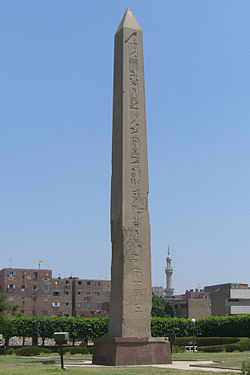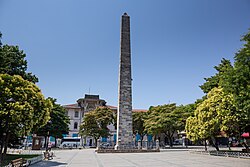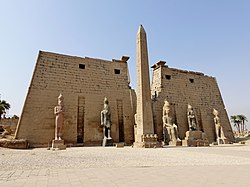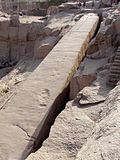Obelisk
An obelisk is a monument made out of stone, much like a column but supporting nothing.
Obelisks were erected by Ancient Egyptians for commemoration. Obelisks were usually made of a single piece of stone.
A bird's eye view of obelisk is square and this structure has gradually tapering four sides and its ends in a pyramidal top.
Obelisks originated with the holy stone of sanctuary which served the sun god, Ra, in Heliopolis. There usually was a pair in front of a gate or sanctuary, and on each side of obelisk there were written hymns and some actions of the of king in hieroglyphics.
Obelisks can have interior spaces.
There are similar forms of obelisks in Europe and America, and some were taken from Egypt by Europeans and Americans. The Washington Monument is a large, modern, built obelisk.
Obelisk Media
One of the two Luxor Obelisks, on the Place de la Concorde in Paris; a red granite monolithic column, 23 metres (75 feet) high, including the base, which weighs over 250 metric tons (280 short tons).
Lateran Obelisk in Piazza San Giovanni in Laterano, Rome. With its height of 32.18 metres (105.6 feet) (with the base and the cross it reaches 45.70 m) it is the largest standing ancient monolithic obelisk in the world.
The Obelisk of Tuthmosis III, Istanbul, Turkey
Flaminio Obelisk of Ramesses II from Heliopolis stands in the centre of the Piazza del Popolo, Rome.
The Dutch Golden Age painter Bartholomeus Breenbergh placed an obelisk in the background of his 1655 painting Joseph Sells Grain
The Walled Obelisk in Istanbul, Turkey
Pylon of the Temple of Luxor with the remaining Luxor Obelisk in front (the second is today on the Place de la Concorde in Paris)
Tip of Hatshepsut's fallen obelisk, Karnak Temple Complex, Luxor, Egypt
Unfinished obelisk, Aswan, Egypt
Related pages
| Wikimedia Commons has media related to Lua error in Module:Commons_link at line 62: attempt to index field 'wikibase' (a nil value).. |









